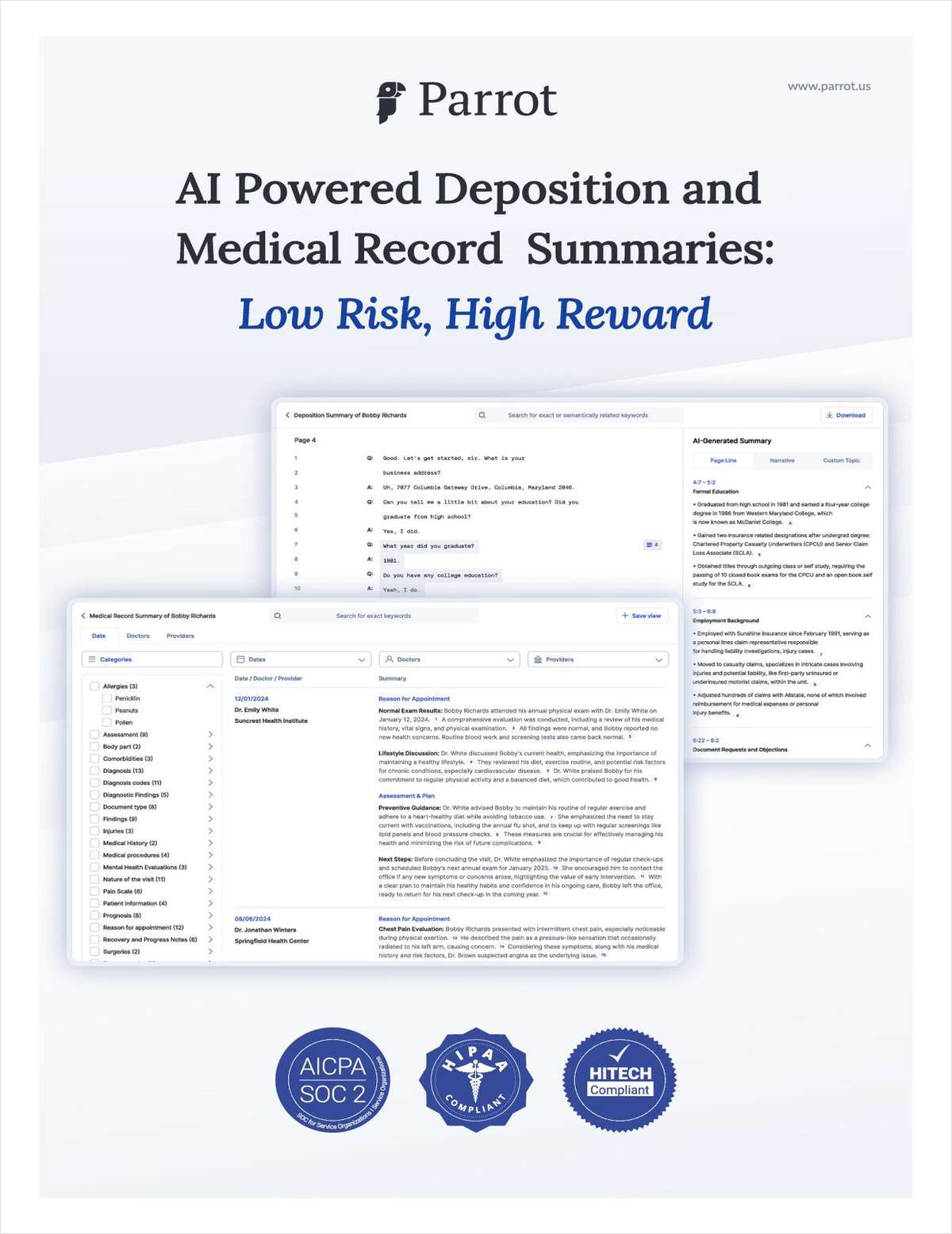Why Analytics Can Be Risky in the Wrong Hands
Having the most expensive or advanced tool in the toolbox doesn't matter if you don't know how to use it, and if you're not using those tools properly, there are risks everywhere.
February 05, 2021 at 12:01 PM
7 minute read
Recent years have seen dramatic advancements in e-discovery software, with some powerful analytics capabilities now often integrated as standard features instead of expensive add-ons. Simultaneously, e-discovery platforms have become increasingly user-friendly, with visually appealing interfaces that make it easier for users to view, manage and produce their data — or so they think.
In reality, the accessibility of analytics platforms can sometimes lead users to believe they understand the platforms better than they actually do. If a user is too emboldened, they may end up making a mistake that negatively impacts their case, such as not producing responsive documents or accidentally producing privileged information.
Having the most expensive or advanced tool in the toolbox doesn't matter if you don't know how to use it, and if you're not using those tools properly, there are risks everywhere. Here are a few examples of areas where inexperienced users tend to go wrong in their use of analytics and search tools:
- Incorrect tagging of documents. Analytics tools are only as good as the data that's fed into them, and a big mistake made by inexperienced users is to not tag documents correctly. A common example would be a responsive document that's attached to a nonresponsive email. It might seem correct to tag the email itself because of its attachment, as often was the normal practice before the use of analytics. However, because there's nothing responsive in the body of the email, tagging it will only make the analytics model less effective at best, or result in incorrect decisions by those tools at worst.
- Over-reliance on basic search functions. Search tools are powerful, but they're not foolproof. When running searches, inexperienced users sometimes overlook flaws in the underlying data that can affect the quality of their search results. Variations or misspellings of a name, or text that is contained in a screenshot or other image, can be easily missed.
- Incorrect handling of privilege review. Sometimes attorneys clearly mark documents in a data set as privileged, but when they don't, a close read of a document may be necessary to ascertain that it's privileged — for instance, a brief mention in an email chain about the topic under discussion. Users shouldn't assume that an analytics model is going to automatically catch that. Some parties still do rely on clawback agreements that allow them to assert privilege over documents after they've been produced to the other party. But, as the old saying goes, you can't un-ring a bell. In some cases, if you try to claw back a document, the other party might claim that you've waived privilege by producing it, at which point you'd have a fight on your hands — a fight that is becoming harder to win. Recently, we worked with a client that was trying to produce documents on a tight deadline. They wanted to produce and send over everything that came up from a search in order to get the job done as quickly and as cheaply as possible. We advised the client that they were risking a waiver of privilege and successfully convinced the counsel to change course, thereby protecting the client's privileged documents. In general, if you have something you don't want the other side to see, don't rely on technology or clawback agreements alone to save you after you've already sent data out the door.
- Incomplete production of documents. Two standard analytics tools, email threading and deduplication, are often used to reduce redundancy in a data set before review. For instance, in an email thread that contains 20 messages, only the final email in the conversation would need to be included for review, since it fully includes all previous communications. However, depending on your production protocol agreement with the opposing party, you might need to produce all 20 messages in the conversation as separate documents, to make it easier to understand the flavor of a conversation. Not doing so could violate your production protocol order, and you would run the risk of sanctions from the court and/or increased costs from having to run the production over again to correct the deficiency. Producing only the most inclusive emails is not a bad strategy, but you must make sure that all parties have agreed to do so, and that they understand how to identify, handle and produce emails that branch out into separate discussion threads, too.
The Math Behind the Tools
As straightforward as analytics platforms might appear on the surface, using them effectively comes down to understanding the math behind the tools. Risk and probability factor greatly into the work done by e-discovery professionals.
This content has been archived. It is available through our partners, LexisNexis® and Bloomberg Law.
To view this content, please continue to their sites.
Not a Lexis Subscriber?
Subscribe Now
Not a Bloomberg Law Subscriber?
Subscribe Now
NOT FOR REPRINT
© 2025 ALM Global, LLC, All Rights Reserved. Request academic re-use from www.copyright.com. All other uses, submit a request to [email protected]. For more information visit Asset & Logo Licensing.
You Might Like
View All
Empowering Your Lawyers: A Marketing Team’s Guide to Achieving Goals and Fostering Lawyer Satisfaction
9 minute read
Change Is Coming in the Trump Era. For Big Law, Change Is Already Here
6 minute read

'If the Job Is Better, You Get Better': Chief District Judge Discusses Overcoming Negative Perceptions During Q&A
Trending Stories
Who Got The Work
J. Brugh Lower of Gibbons has entered an appearance for industrial equipment supplier Devco Corporation in a pending trademark infringement lawsuit. The suit, accusing the defendant of selling knock-off Graco products, was filed Dec. 18 in New Jersey District Court by Rivkin Radler on behalf of Graco Inc. and Graco Minnesota. The case, assigned to U.S. District Judge Zahid N. Quraishi, is 3:24-cv-11294, Graco Inc. et al v. Devco Corporation.
Who Got The Work
Rebecca Maller-Stein and Kent A. Yalowitz of Arnold & Porter Kaye Scholer have entered their appearances for Hanaco Venture Capital and its executives, Lior Prosor and David Frankel, in a pending securities lawsuit. The action, filed on Dec. 24 in New York Southern District Court by Zell, Aron & Co. on behalf of Goldeneye Advisors, accuses the defendants of negligently and fraudulently managing the plaintiff's $1 million investment. The case, assigned to U.S. District Judge Vernon S. Broderick, is 1:24-cv-09918, Goldeneye Advisors, LLC v. Hanaco Venture Capital, Ltd. et al.
Who Got The Work
Attorneys from A&O Shearman has stepped in as defense counsel for Toronto-Dominion Bank and other defendants in a pending securities class action. The suit, filed Dec. 11 in New York Southern District Court by Bleichmar Fonti & Auld, accuses the defendants of concealing the bank's 'pervasive' deficiencies in regards to its compliance with the Bank Secrecy Act and the quality of its anti-money laundering controls. The case, assigned to U.S. District Judge Arun Subramanian, is 1:24-cv-09445, Gonzalez v. The Toronto-Dominion Bank et al.
Who Got The Work
Crown Castle International, a Pennsylvania company providing shared communications infrastructure, has turned to Luke D. Wolf of Gordon Rees Scully Mansukhani to fend off a pending breach-of-contract lawsuit. The court action, filed Nov. 25 in Michigan Eastern District Court by Hooper Hathaway PC on behalf of The Town Residences LLC, accuses Crown Castle of failing to transfer approximately $30,000 in utility payments from T-Mobile in breach of a roof-top lease and assignment agreement. The case, assigned to U.S. District Judge Susan K. Declercq, is 2:24-cv-13131, The Town Residences LLC v. T-Mobile US, Inc. et al.
Who Got The Work
Wilfred P. Coronato and Daniel M. Schwartz of McCarter & English have stepped in as defense counsel to Electrolux Home Products Inc. in a pending product liability lawsuit. The court action, filed Nov. 26 in New York Eastern District Court by Poulos Lopiccolo PC and Nagel Rice LLP on behalf of David Stern, alleges that the defendant's refrigerators’ drawers and shelving repeatedly break and fall apart within months after purchase. The case, assigned to U.S. District Judge Joan M. Azrack, is 2:24-cv-08204, Stern v. Electrolux Home Products, Inc.
Featured Firms
Law Offices of Gary Martin Hays & Associates, P.C.
(470) 294-1674
Law Offices of Mark E. Salomone
(857) 444-6468
Smith & Hassler
(713) 739-1250








